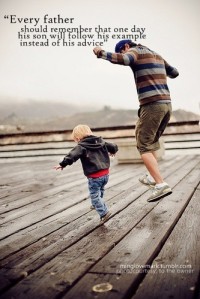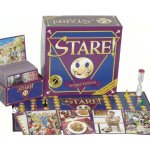 Morning routines, evening routines, and even weekend routines… this is an ongoing challenge for parents of young children. We know the importance of keeping kids on a consistent schedule, but it can be quite stressful making the process smooth. As a mom of two young kids and a child therapist, including one toddler, making this process easier was important to me. As a therapist, I also saw this to be a struggle for many parents of the children I was seeing.
Morning routines, evening routines, and even weekend routines… this is an ongoing challenge for parents of young children. We know the importance of keeping kids on a consistent schedule, but it can be quite stressful making the process smooth. As a mom of two young kids and a child therapist, including one toddler, making this process easier was important to me. As a therapist, I also saw this to be a struggle for many parents of the children I was seeing.
The Challenges with Routine
- Distractions. The temptation for the kids to want to play instead of eat dinner, and for me to watch the news instead of prepare dinner, is one example of how distractions affect us at my house.
- Stress. Getting yourself and the kids ready in the morning is no easy task and often very stressful. You do “what you have to do” just to get out the door on time.
- Change. There’s no getting around the fact that changes in your family/life happen and adjustments have to be made. New babies are born, job schedules change, kids start new extra curricular activities… all requiring a modification to your routine.
- Lack of Energy. I don’t know any parent who feels they get enough sleep and with all the activities of life today, disregarding a routine is very tempting, especially when you kids are resistant (bath, bed, etc.).
How a Routine Chart Is Helpful
- Visual. Kids respond well to a visual picture of the routine. I use pictures of each stage of the morning, evening, or day.
- Active Participation. On the chart I created, kids move the picture of the completed task from start to finish. It’s similar to the satisfaction we get when when we check off or mark off an item on our “to do” list!
- Variation. As mentioned above, routines change, and sometimes daily. This chart allows for variation and flexibility to meet one’s needs.
- Control. Since the pictures can be arranged in any way, the child may choose the order of certain areas, within the limits set by the parent. For example, the child may put “brush teeth,” “brush hair,” and “get dressed” in the order they desire. This gives the child a sense of control to part of their routine and encourages participation.
- Reinforcement. The child can choose from the rewards allowed by parents. For example, after the morning routine, the child may choose to play the ipad or play with toys for their remaining time, or when they get home that day.
Creating a Routine Chart
I remembered from working with Occupational Therapists for many years, they used activity charts to get kids to participate in all the activities in therapy. I adapted this concept to my own parenting needs, and shared it with some of my clients’ parents. So far, the parents I made a chart for have reported they are finding it useful and the kids are happy to follow the chart and earn their reward. With my own toddler, it was a huge improvement from the battles we were facing every night.
Step 1. I first downloaded Boardmaker Studio by Dynavox Mayer-Johnson. You will want to register for their free 30 day trial if you are not familiar with the program, or have no other use for it. This program offers a lot that I am still discovering and playing with. It will take you a little time to become familiar with the program, but it’s pretty simple to learn.
Step 2. You will want to search for pictures that describe the activities and rewards you will use. Here is a sample of the pictures I downloaded:
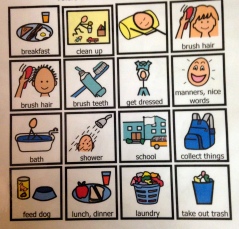
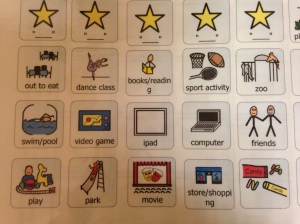
Examples of Activities:
- Breakfast, Lunch, and Dinner
- Bath time
- Bed
- Brush teeth and brush hair
- Get dressed
- Gather things (I used a picture of a back pack)
- School
- Clean Up
- Use Potty
Examples of Rewards:
- Park
- Ipad (This search doesn’t come up, but I found a picture of a laptop and named it Ipad)
- Computer
- TV
- Swimming pool
- Read books
- Play with toys
Step 3. Choose a routine template from Boardmaker Studio. You can modify to your needs, or print out as is. I do not put activity symbols on the routine template because I am going to cut them out separately later.

Step 4. Print your routine template and picture squares.
Step 5. Laminate all the print outs.
Step 6. Cut out each picture square after laminating is complete.
Step 7. Add velcro to the back of each picture square. Add the corresponding side to each square on the routine templete, as well as on the square next to “Reward.”
Step 8. Ready for use! Describe the chart to your child. Be sure to show them the rewards they can choose from, as well as practice moving the squares from top to bottom after they are complete.
Tips on Using Chart
- Play with the chart before showing your child. Decide which activities you want, and for what part of the day. Also, choose the rewards you want to offer, and at what times (you don’t want to offer the park if it’s at the end of the day). Also, I limit choices for my toddler to two at a time.
- Describe how to use the chart, the purpose of the chart, and rewards to your child.
- Show excitement about the chart with your child. They will likely share in your excitement, especially if it means they earn rewards!
- Be consistent! It’s important to use this regularly to reinforce habit, as well as show your commitment to the established routines.
- Let the child move the squares from the “To Do” section to “Finished.” Consider how you would feel if someone else crossed of an item on your list… no way! 🙂
- Print one general chart, or get more specific (morning, evening, etc.)
- And finally, modify the chart to meet your needs. If the sample I have provided doesn’t work, then make a change. I continue to modify the chart for my home, as well as for my clients… no shame! 🙂
Alternate Use: Chores
I have also used this same concept for chores. Place the chores for the week at the top and as the child completes the chore, they move to the bottom. The reward can be at the end of the week.
I would love to know how this works for you, or if you have another great idea for getting kids on a routine!
If you would like information on my services, please visit my website at www.kimscounseling.com!
You May Also Like:

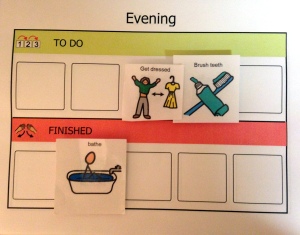

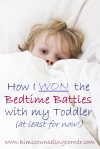
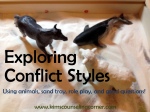
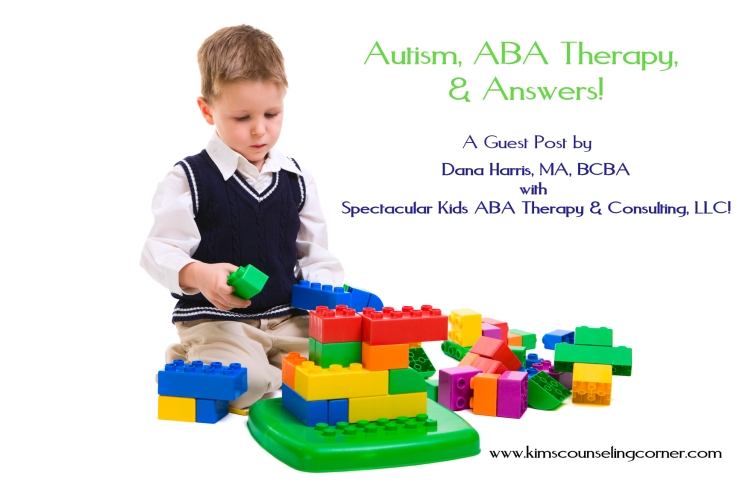
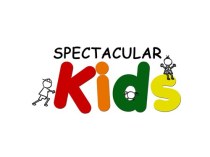
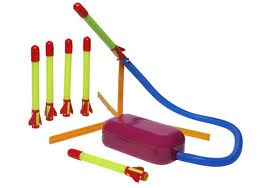


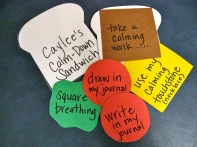


 After reading
After reading  The Anger Management Puppet Set includes 3 Puppets, a CD of recorded script and catchy original music, and a separate guide. The two scripts and one CD that are designed to help counselors, teachers, or parents teach children about how to be a good sport and how to deal with anger. These puppets are suitable for small and large hands are quite durable. They are made for long term use.
The Anger Management Puppet Set includes 3 Puppets, a CD of recorded script and catchy original music, and a separate guide. The two scripts and one CD that are designed to help counselors, teachers, or parents teach children about how to be a good sport and how to deal with anger. These puppets are suitable for small and large hands are quite durable. They are made for long term use.
 These cards depict different elements of the anger cycle. Using appropriate cards in a variety of activities discussed in the accompanying booklet will facilitate awareness of the causes of anger and help to work out ways to overcome those triggers. For use one-to-one or with small or large groups.
These cards depict different elements of the anger cycle. Using appropriate cards in a variety of activities discussed in the accompanying booklet will facilitate awareness of the causes of anger and help to work out ways to overcome those triggers. For use one-to-one or with small or large groups. In this new game, players have fun playing dominoes while learning to manage their anger and problem-solve in a thoughtful, assertive, and respectful way.
In this new game, players have fun playing dominoes while learning to manage their anger and problem-solve in a thoughtful, assertive, and respectful way. two internal dialog techniques—Thought Stopping and Self-Talk—kids can stop anger in its tracks. By simply playing cards, they learn to envision a stop sign whenever their anger is triggered and to replace their angry thoughts with more positive responses.
two internal dialog techniques—Thought Stopping and Self-Talk—kids can stop anger in its tracks. By simply playing cards, they learn to envision a stop sign whenever their anger is triggered and to replace their angry thoughts with more positive responses. Smart and Angry is a therapeutic and educational board game designed to teach young people specific skills that will help them look objectively at anger-provoking situations and react in a thoughtful, assertive, and respectful way. It is not the anger that gets kids in trouble, but rather the actions they take when they are angry, that determine whether they can solve the problem or make things worse. In addition, many people misread situations and become angry when it is inappropriate.
Smart and Angry is a therapeutic and educational board game designed to teach young people specific skills that will help them look objectively at anger-provoking situations and react in a thoughtful, assertive, and respectful way. It is not the anger that gets kids in trouble, but rather the actions they take when they are angry, that determine whether they can solve the problem or make things worse. In addition, many people misread situations and become angry when it is inappropriate. The Positive Ways to Handle Anger Card Game is played like the classic Old Maid card game. There are 20 sets of matching cards that show positive, safe ways to handle angry feelings. Each game includes playing instructions, information about anger and how to use the game as an educational tool.
The Positive Ways to Handle Anger Card Game is played like the classic Old Maid card game. There are 20 sets of matching cards that show positive, safe ways to handle angry feelings. Each game includes playing instructions, information about anger and how to use the game as an educational tool.
 This fast-paced therapeutic card game helps children control their anger in the moment, practice effective anger management techniques, and understand what anger looks and feels like. Mad Dragon plays like the popular card game Uno.
This fast-paced therapeutic card game helps children control their anger in the moment, practice effective anger management techniques, and understand what anger looks and feels like. Mad Dragon plays like the popular card game Uno.
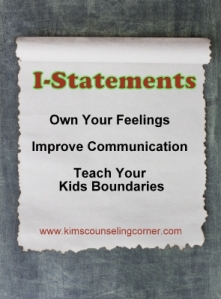



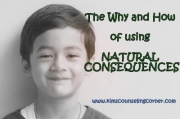
![[Cartoon: Staying up late and falling asleep in school]](https://i0.wp.com/www.dshs.wa.gov/ca/fosterparents/training/images/nl2a.gif)

 Then add an evil laugh right after (Muuuaaahhhhaaahhaa!). Just kidding, but it is sort of implied!! 🙂
Then add an evil laugh right after (Muuuaaahhhhaaahhaa!). Just kidding, but it is sort of implied!! 🙂



